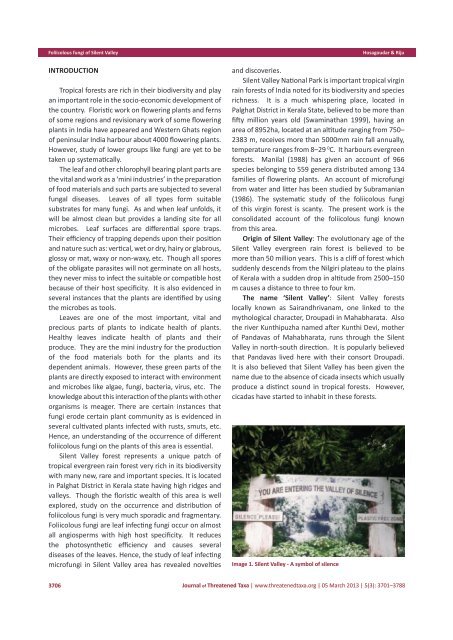PDF - Journal of Threatened Taxa
PDF - Journal of Threatened Taxa
PDF - Journal of Threatened Taxa
Create successful ePaper yourself
Turn your PDF publications into a flip-book with our unique Google optimized e-Paper software.
Foliicolous fungi <strong>of</strong> Silent ValleyINTRODUCTIONTropical forests are rich in their biodiversity and playan important role in the socio-economic development <strong>of</strong>the country. Floristic work on flowering plants and ferns<strong>of</strong> some regions and revisionary work <strong>of</strong> some floweringplants in India have appeared and Western Ghats region<strong>of</strong> peninsular India harbour about 4000 flowering plants.However, study <strong>of</strong> lower groups like fungi are yet to betaken up systematically.The leaf and other chlorophyll bearing plant parts arethe vital and work as a ‘mini industries’ in the preparation<strong>of</strong> food materials and such parts are subjected to severalfungal diseases. Leaves <strong>of</strong> all types form suitablesubstrates for many fungi. As and when leaf unfolds, itwill be almost clean but provides a landing site for allmicrobes. Leaf surfaces are differential spore traps.Their efficiency <strong>of</strong> trapping depends upon their positionand nature such as: vertical, wet or dry, hairy or glabrous,glossy or mat, waxy or non-waxy, etc. Though all spores<strong>of</strong> the obligate parasites will not germinate on all hosts,they never miss to infect the suitable or compatible hostbecause <strong>of</strong> their host specificity. It is also evidenced inseveral instances that the plants are identified by usingthe microbes as tools.Leaves are one <strong>of</strong> the most important, vital andprecious parts <strong>of</strong> plants to indicate health <strong>of</strong> plants.Healthy leaves indicate health <strong>of</strong> plants and theirproduce. They are the mini industry for the production<strong>of</strong> the food materials both for the plants and itsdependent animals. However, these green parts <strong>of</strong> theplants are directly exposed to interact with environmentand microbes like algae, fungi, bacteria, virus, etc. Theknowledge about this interaction <strong>of</strong> the plants with otherorganisms is meager. There are certain instances thatfungi erode certain plant community as is evidenced inseveral cultivated plants infected with rusts, smuts, etc.Hence, an understanding <strong>of</strong> the occurrence <strong>of</strong> differentfoliicolous fungi on the plants <strong>of</strong> this area is essential.Silent Valley forest represents a unique patch <strong>of</strong>tropical evergreen rain forest very rich in its biodiversitywith many new, rare and important species. It is locatedin Palghat District in Kerala state having high ridges andvalleys. Though the floristic wealth <strong>of</strong> this area is wellexplored, study on the occurrence and distribution <strong>of</strong>foliicolous fungi is very much sporadic and fragmentary.Foliicolous fungi are leaf infecting fungi occur on almostall angiosperms with high host specificity. It reducesthe photosynthetic efficiency and causes severaldiseases <strong>of</strong> the leaves. Hence, the study <strong>of</strong> leaf infectingmicr<strong>of</strong>ungi in Silent Valley area has revealed noveltiesHosagoudar & Rijuand discoveries.Silent Valley National Park is important tropical virginrain forests <strong>of</strong> India noted for its biodiversity and speciesrichness. It is a much whispering place, located inPalghat District in Kerala State, believed to be more thanfifty million years old (Swaminathan 1999), having anarea <strong>of</strong> 8952ha, located at an altitude ranging from 750–2383 m, receives more than 5000mm rain fall annually,temperature ranges from 8–29 0 C. It harbours evergreenforests. Manilal (1988) has given an account <strong>of</strong> 966species belonging to 559 genera distributed among 134families <strong>of</strong> flowering plants. An account <strong>of</strong> micr<strong>of</strong>ungifrom water and litter has been studied by Subramanian(1986). The systematic study <strong>of</strong> the foliicolous fungi<strong>of</strong> this virgin forest is scanty. The present work is theconsolidated account <strong>of</strong> the foliicolous fungi knownfrom this area.Origin <strong>of</strong> Silent Valley: The evolutionary age <strong>of</strong> theSilent Valley evergreen rain forest is believed to bemore than 50 million years. This is a cliff <strong>of</strong> forest whichsuddenly descends from the Nilgiri plateau to the plains<strong>of</strong> Kerala with a sudden drop in altitude from 2500–150m causes a distance to three to four km.The name ‘Silent Valley’: Silent Valley forestslocally known as Sairandhrivanam, one linked to themythological character, Droupadi in Mahabharata. Alsothe river Kunthipuzha named after Kunthi Devi, mother<strong>of</strong> Pandavas <strong>of</strong> Mahabharata, runs through the SilentValley in north-south direction. It is popularly believedthat Pandavas lived here with their consort Droupadi.It is also believed that Silent Valley has been given thename due to the absence <strong>of</strong> cicada insects which usuallyproduce a distinct sound in tropical forests. However,cicadas have started to inhabit in these forests.Image 1. Silent Valley - A symbol <strong>of</strong> silence3706<strong>Journal</strong> <strong>of</strong> <strong>Threatened</strong> <strong>Taxa</strong> | www.threatenedtaxa.org | 05 March 2013 | 5(3): 3701–3788

















